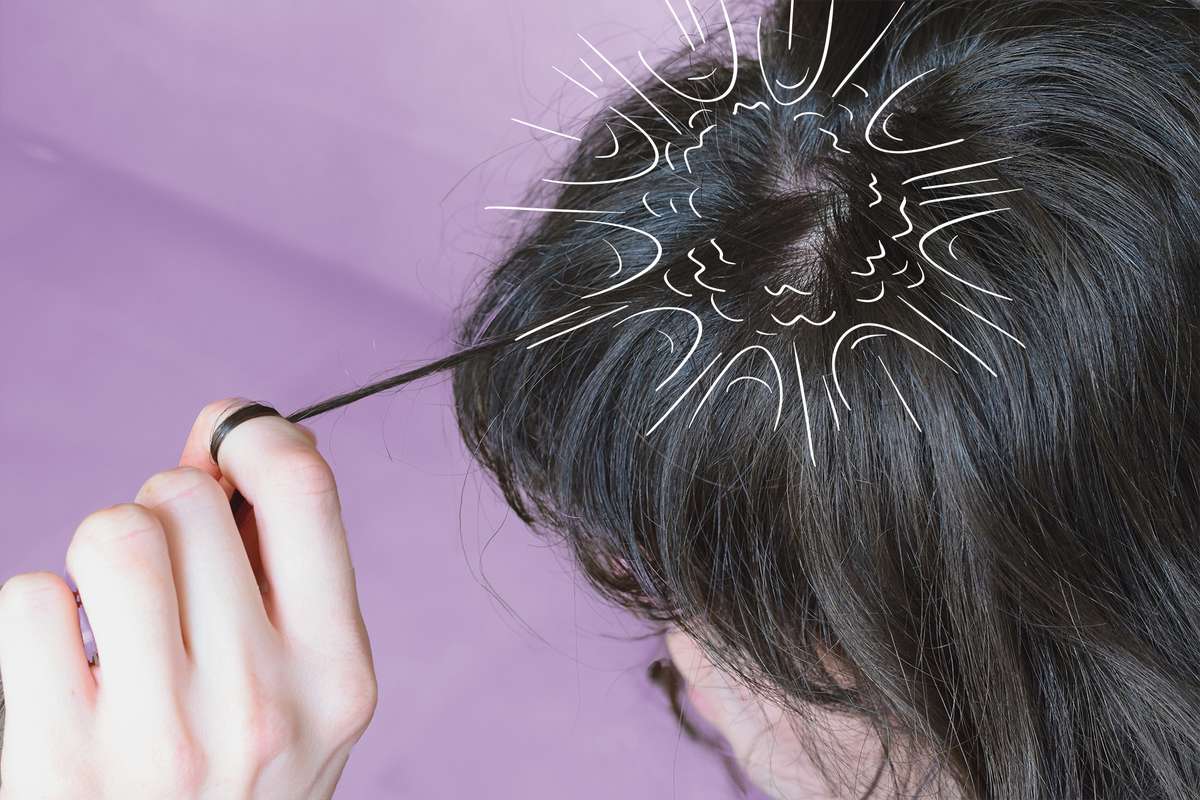
You can crack your knuckles, your neck, your back—and, according to TikTok, apparently even your scalp. Hair cracking or scalp popping is a new-to-some phenomenon that's been circulating the social networking site recently, and it's got people intrigued, confused, and a little concerned.
The hashtag #ScalpPopping has garnered over 6.4 million views on the site so far—the top video by a TikTok user named Yana (@yanasemerly), which has more than 820,000 likes and 4.9 million views. In the video, Yana and an unnamed friend try the scalp popping technique, each taking a small section of the other's hair, twisting it around their fingers, and pulling from up. The girls both act shocked when the act elicits a popping noise.
But it's not just Yara and her friend—tons of others on the app have also tried their hand at scalp popping or hair cracking. In another video, user @gizzybautista (aka, Giselle) takes a section of her hair in her hand, pulls it away from her scalp, and looks pretty surprised at the popping noise it makes. "I was shook," she wrote in the caption. The below video shows another woman—not Giselle–performing scalp popping on YouTube.
Another TikTokker, Rebekah Grider (@rebekahgrider) also hopped on the trend. "Guys, I saw this TikTok of these girls [referring to Yana and her friend] and they were doing, like, scalp popping, otherwise known as hair cracking, and I tried it and I looked it up and it's real and it works," she said in the video, before doing it for the camera. After she twisted her hair, pulled it, and heard a popping noise, she responded with "Ew!" and proceeded to do it a few more times—just as surprised by the sound as the first time she did it.
But not everyone has had a good experience with the scalp popping trend. After her first video, Gisele shared another, revealing that she tried to do it again, but couldn't. Other TikTokkers also reached out to her, saying they tried the trend and ended up with bald spots (presumably a risk when you pull your hair really, really hard). "If it won't pop that easily then don't do it," she said. "It won't work on you."
Clearly, there's a lot of interest behind this scalp popping/hair cracking trend—so what is it, exactly? Real talk: None of the dermatologists we contacted were able to speak on the trend, but Jon Musgrave, an NYC-based licensed massage therapist was able to key us into the practice, what it's used for, and if it's safe to do.
What is scalp popping—and is it even safe?
To be totally honest, there isn't a ton of information on scalp popping or hair cracking online. One Reddit post five months ago from u/lizfromdarkplace shared her own hair cracking experience while receiving a facial at an Asian spa. "I have never felt a stranger sensation in my life and am wondering," she wrote, while also acknowledging the lack of information on the topic.
But Musgrave tells Health that he's been aware of the practice for many years. "I first became aware of it as something Mexican women do to help relieve heat-induced migraines," he said. "It's not a standard Western massage technique, and it's not something that I would do to myself or to someone else."
While scalp popping seems to be a cultural practice—comments on Reddit mention Asian or Turkish origins—Musgrave has some major concerns with the technique, especially if you're a first-time scalp popper and don't know exactly what you're doing. First, he highlights the potential of tearing either the skin or the connective tissues underneath. Plus, there's the risk of causing strain in the neck as it gets pulled along with the head. He compares it to cracking your own neck—"it's something that many people do but is not particularly safe, and should be left to someone who has the training and experience to do it safely."
If you feel like you have tension on your scalp—"the skin on the head adhering to the skull is a pretty common issue," Musgrave says—that are a couple of simple techniques you could try that won't rip your hair out, tear your skin, or strain your neck. Musgrave suggests placing all four fingers of both hands onto either side of your skull, and then making small circles, first in one direction and then the other, to move the skin across the skull. "You can then move your hands to different places so that you're moving the skin on the front, back, sides, and top of the skull," he explains. Another option—one that might work for people with longer hair—is to take large sections of hair and pull firmly but slowly to drag the skin away from the skull. "This has a similar effect, without the safety concerns," he says.
And as for the "popping" noise that has TikTok fascinated, Musgrave doesn't know exactly what causes it. "It could be that it's the fascia [a thin casing of connective tissue that holds bones, muscles, organs, blood vessels, and nerve endings in place] ripping as the skin pulls away from the skull, but I'd say it's more likely that it's just suction," he suggests. "When the skin gets pulled away from the bones quickly, it creates a vacuum that 'pops' as the edges lift and the space gets filled in by liquid, like pulling a suction cup off the shower wall."
It may be best to file this one under "interesting things we've seen on TikTok" and forego actually trying it. Instead, opt for seeing a qualified massage therapist if you have tension in your scalp, or suffer from migraines that just won't quit.
Source: Read Full Article
